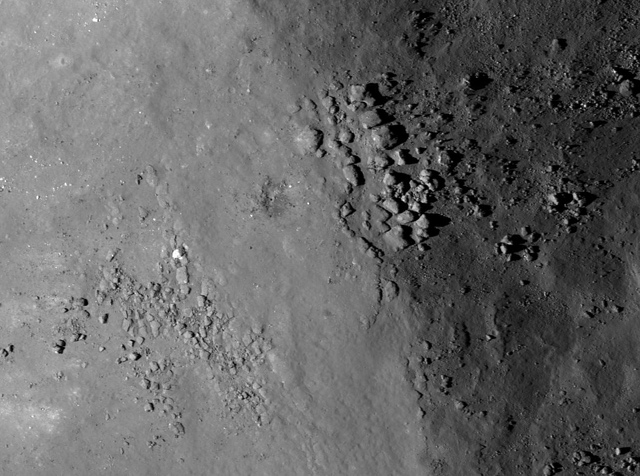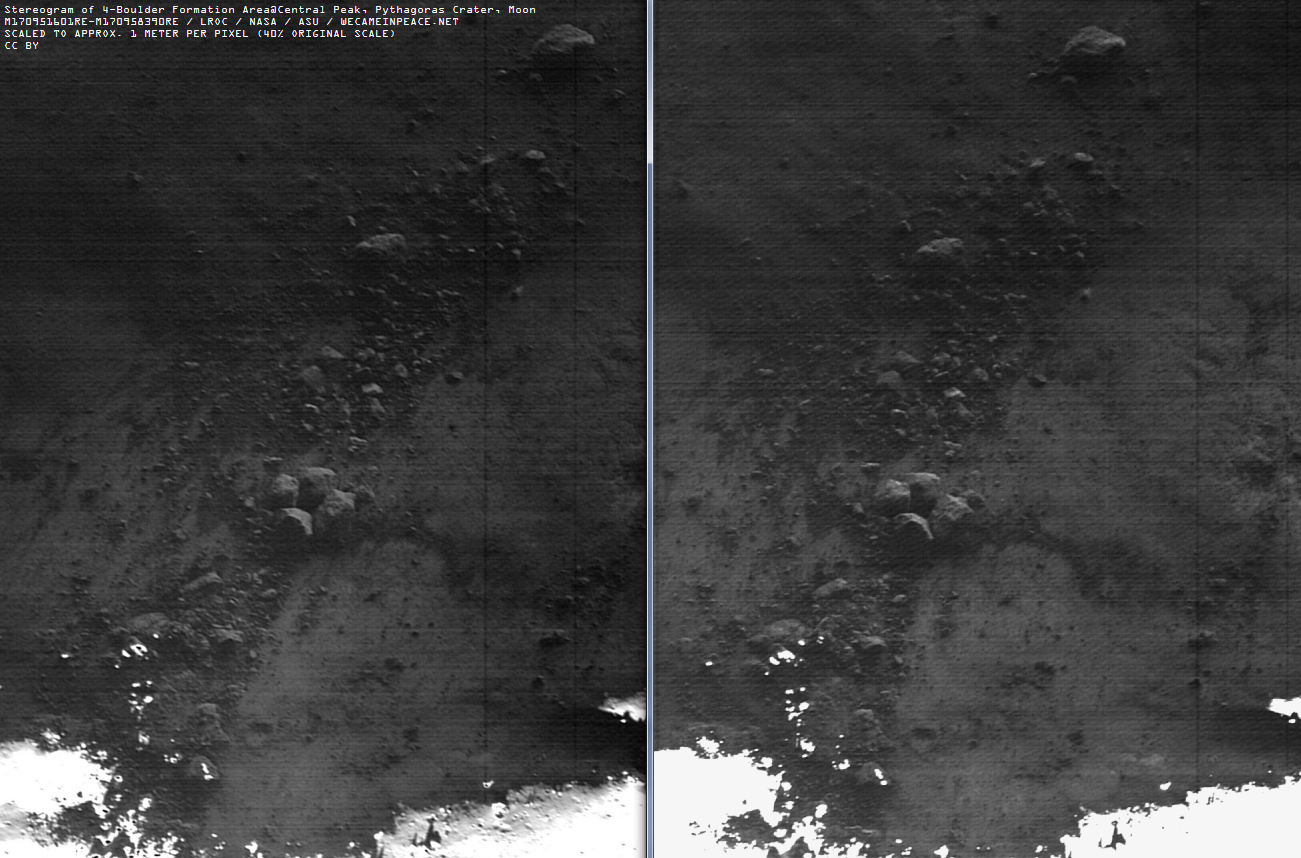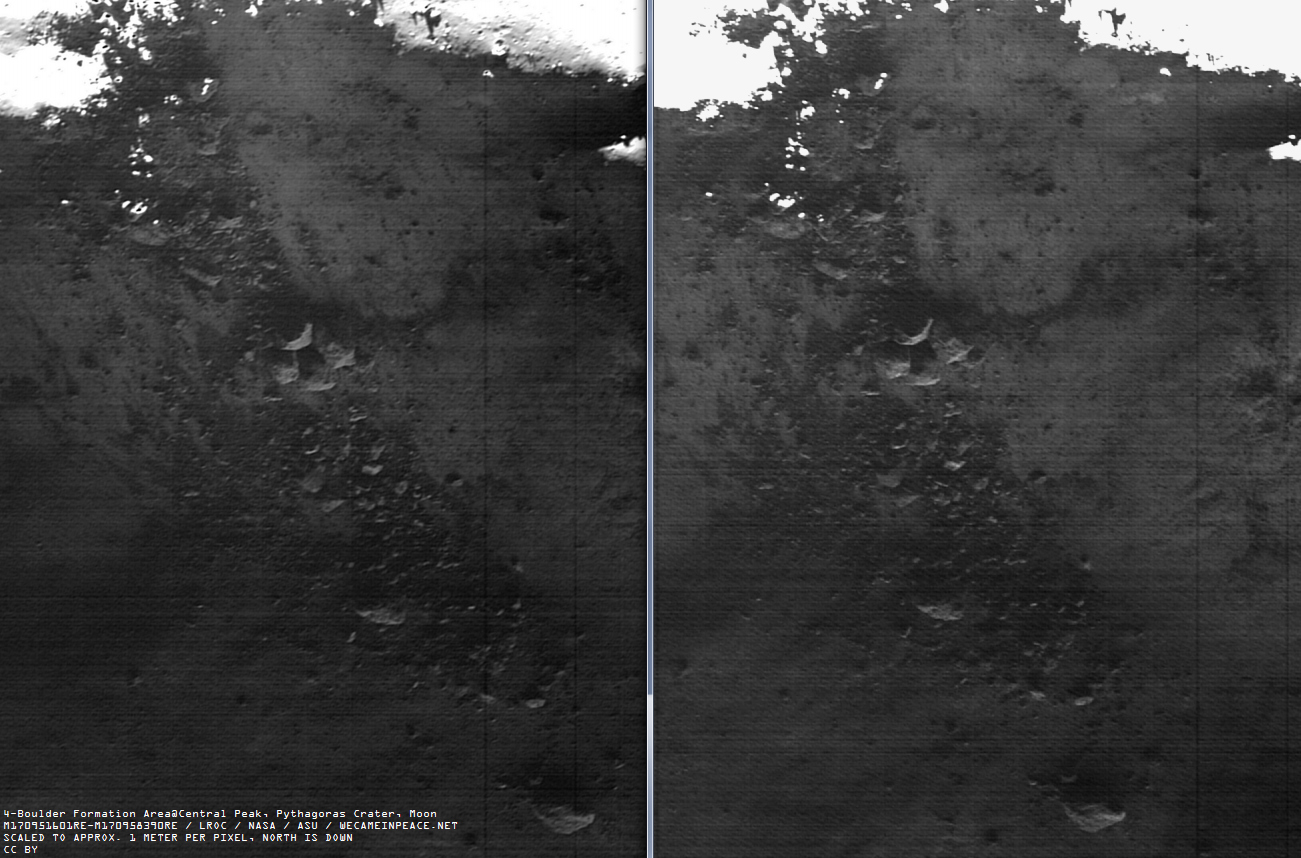It looks like you're using an Ad Blocker.
Please white-list or disable AboveTopSecret.com in your ad-blocking tool.
Thank you.
Some features of ATS will be disabled while you continue to use an ad-blocker.
share:
3D visualisation: target.lroc.asu.edu...
The boulders are almost right at the top of the central peak, and located on a very steep slope. This looks like impact rubble or lava chunks that got exposed through erosion and broke away. You can see similar boulders lining the top of the central peak. This remind me of this image from an article about lunar erosion: blog.moonzoo.org...

The boulders are almost right at the top of the central peak, and located on a very steep slope. This looks like impact rubble or lava chunks that got exposed through erosion and broke away. You can see similar boulders lining the top of the central peak. This remind me of this image from an article about lunar erosion: blog.moonzoo.org...

The centre of the image appears to be a crust formed from a lava flow and looks like it is eroding away at the sides as slabs of the lava crust are splitting away.
Aside from the public 1 wonders was this area observed previously clear of these formations. And if so up to what time period were they then
discovered/observed?
Originally posted by Ophiuchus 13
Aside from the public 1 wonders was this area observed previously clear of these formations. And if so up to what time period were they then discovered/observed?
No, why would you think that? The boulders are (barely) visible in all hi-rez images from that area. They have been there probably for millions of years.
Originally posted by wildespace
No, why would you think that?
Because 1 feels the Lunar surface has been scanned so 35 years ago where these there or not and if so why just now detected publicly 1 wonders.
edit on 8/23/13 by Ophiuchus 13 because: (no reason given)
Originally posted by Ophiuchus 13
Originally posted by wildespace
No, why would you think that?
Because 1 feels the Lunar surface has been scanned so 35 years ago where these there or not and if so why just now detected publicly 1 wonders.edit on 8/23/13 by Ophiuchus 13 because: (no reason given)
The Moon has been scanned in such high detail only in the last few years, by the Lunar Reconnaissance Orbiter. Those boulders appear on all of those images, as far as I'm aware. We don't have any pictures of that area from 35 years ago, but that doesn't mean they weren't there before and just magically appeared. These boulders don't look much different from other boulders visible in the area, and like I explained they are most likely the rubble from the impact that created the crater, or chunks of lava that broke off. Or, judging by the article I just came across at the-moon.wikispaces.com... they might be rocks "excavated" by the impact:
Central peaks form by the rebound of the impact point, bringing previously buried rocks up into view. Central peaks excavate rocks from depths of 5-30 km (the deep ones from basin rings) and thus are probes of the lunar subsurface.
edit on 23-8-2013 by wildespace because: (no reason
given)
Originally posted by chrome413
I'm just surfing through all the comments and am wondering- Of the explanations put forth, which is the most simple? I'll place my bets on that one.
It's whichever explains complex natural phenomena in the simplest terms (and with the fewest assumptions). The keyword is complex. Is a bitter irony, I tell you! Like making a precise sculpture in a hurricane while experiencing an earthquake and having shaky hands due to starvation!
I think the principle of Occam's Razor is to make a scultpure without the excess. Another words, if you're sculpting a penguin then you cut away the excess that makes it look like something else. The simplest theory for natural phenomena has to be able to explain all of the data just as a sculpture of a penguin has to actually look like a penguin, so it's not really all that "simple".
It's science people making science seem simple, when ti's really not simple at all. It's hundreds and perhaps thousands of years of observation and experimentation. It's doubtful the scientific method would exist if not for the invention of the wheel or the advent of agriculture. Without such things, we'd probably still be stuck in caves or in tribal camps. It's people dedicating their entire lives to tackling problems and quantifying them and formulating theories to explain them. Repeated generations of people doing this and rechecking old theories and even making new ones.
I think humans have always tried to explain the universe. Most people explain it by turning to religion, but some have always tried to be explicit. Thousands of years ago we did not have access to a wide pool of knowledge. People only had crude tools and a limited storehouse of past knowledge. They were consistently afflicted by natural disaster and disease and superstition and war, but they persevered. They did the best they could and thanks to them we're where we're today.
edit on 29-8-2013 by jonnywhite because: (no reason given)
Most readers of this forum are sophisticated enough to be aware of stereograms, and the popular
cross-eye viewing technique to gain depth perception from 2d images using the eyeballs
only.
For those that possess the skill already, dig right in with the thrill/excitement/etc of knowing that you are looking at area of the Moon nobody has seen before and in 3D no less. I keep saying never before seen because it's the truth. The concept of being the first human in history to do something may be surreal but make no mistake, the claim is valid as we keep exhaustive record of human exploration of the Moon. Well worth learning the cross-eye 3D viewing technique for those who don't know. Just follow the link above.
With this added perception of depth, it now becomes clear that there is a 150m or 500ft monster sized boulder sitting on the apex of this peak along with other things that become apparent from added depth perception. The more we dig, the more we learn.
Reduced scale image.

Link to 1m resolution originally uploaded image.

Disclaimer: I am not aware of anyone who experienced vision loss from trying to learn or using the cross-eye 3D viewing technique. However, view this image at your own risk. I am not responsible for your health.
For those that possess the skill already, dig right in with the thrill/excitement/etc of knowing that you are looking at area of the Moon nobody has seen before and in 3D no less. I keep saying never before seen because it's the truth. The concept of being the first human in history to do something may be surreal but make no mistake, the claim is valid as we keep exhaustive record of human exploration of the Moon. Well worth learning the cross-eye 3D viewing technique for those who don't know. Just follow the link above.
With this added perception of depth, it now becomes clear that there is a 150m or 500ft monster sized boulder sitting on the apex of this peak along with other things that become apparent from added depth perception. The more we dig, the more we learn.
Reduced scale image.

Link to 1m resolution originally uploaded image.

Disclaimer: I am not aware of anyone who experienced vision loss from trying to learn or using the cross-eye 3D viewing technique. However, view this image at your own risk. I am not responsible for your health.
edit on 31-8-2013 by PINGi14 because: disclaimer
Stereogram of the four-boulder formation using two independently captured views of same area. I didn't think it was possible for the eyeballs to focus
on large stereogram but it works like a charm (with practice) so this one covers larger area at better resolution.
Because the image is pretty big, be sure to start attempting 3D while pretty far away from the monitor as it's easier to gain focus. From there, if you feel comfortable move closer but I don't think it's possible to focus on the entire image at close distance but instead try working on smaller section by focusing on specific objects.. TIP: Don't forget to blink. It will help gain/adjust focus and keep your eyes in top shape.
Pretty cool that we started with a single fuzzy 2D image of the formation and ended up with full blown 3D view with improved detail thanks to the fact there were multiple observations the area. Enjoy the view and happy labor day. Note: Caption was added due to quality and includes description, source, attribution, and license.
Reduced scale image.

Link to 1m resolution originally uploaded image.

Because the image is pretty big, be sure to start attempting 3D while pretty far away from the monitor as it's easier to gain focus. From there, if you feel comfortable move closer but I don't think it's possible to focus on the entire image at close distance but instead try working on smaller section by focusing on specific objects.. TIP: Don't forget to blink. It will help gain/adjust focus and keep your eyes in top shape.
Pretty cool that we started with a single fuzzy 2D image of the formation and ended up with full blown 3D view with improved detail thanks to the fact there were multiple observations the area. Enjoy the view and happy labor day. Note: Caption was added due to quality and includes description, source, attribution, and license.
Reduced scale image.

Link to 1m resolution originally uploaded image.

edit on 2-9-2013 by PINGi14 because: tip
I am going to go with natural occurring. But I do want to ask a few questions. Just to put to bed any chances of unnaturally occurring.
1. Looking at the pictures it seems slightly odd that the 4 largest rocks have found themselves together while the rest of the area seems to be composed of smaller debris. If this was from a impact I'd assume anyway there would be many of similar size around.
2. If they each measure 50m the area inside that is still dark in pictures is around 50m as well. So the quickest way to rule out chances of being anything unexplained would be a way to see what's inside. As stated above it takes millions of years for the surface to change. Likewise it would take even longer for what is in the center to be affect because of its " natural " shelter. Correct?
1. Looking at the pictures it seems slightly odd that the 4 largest rocks have found themselves together while the rest of the area seems to be composed of smaller debris. If this was from a impact I'd assume anyway there would be many of similar size around.
2. If they each measure 50m the area inside that is still dark in pictures is around 50m as well. So the quickest way to rule out chances of being anything unexplained would be a way to see what's inside. As stated above it takes millions of years for the surface to change. Likewise it would take even longer for what is in the center to be affect because of its " natural " shelter. Correct?
reply to post by Roacordo
If nature can produce balancing rocks, I'm not surprised that four huge boulders can end up standing together.
Although there are no similar-sized boulders in the immediate vicinity, there are plenty of them scattered or clustered in the area. Four being together is no biggie for me.
If nature can produce balancing rocks, I'm not surprised that four huge boulders can end up standing together.
Although there are no similar-sized boulders in the immediate vicinity, there are plenty of them scattered or clustered in the area. Four being together is no biggie for me.
Originally posted by wildespace
reply to post by Roacordo
If nature can produce balancing rocks, I'm not surprised that four huge boulders can end up standing together.
Although there are no similar-sized boulders in the immediate vicinity, there are plenty of them scattered or clustered in the area. Four being together is no biggie for me.
I don't question at all nature can produce this.
But when I see something that " naturally " occurs that could be used as shelter I like to see what's inside.
Originally posted by Roacordo
I am going to go with natural occurring. But I do want to ask a few questions. Just to put to bed any chances of unnaturally occurring.
1. Looking at the pictures it seems slightly odd that the 4 largest rocks have found themselves together while the rest of the area seems to be composed of smaller debris. If this was from a impact I'd assume anyway there would be many of similar size around.
2. If they each measure 50m the area inside that is still dark in pictures is around 50m as well. So the quickest way to rule out chances of being anything unexplained would be a way to see what's inside. As stated above it takes millions of years for the surface to change. Likewise it would take even longer for what is in the center to be affect because of its " natural " shelter. Correct?
Natural origin is assumed unless proven otherwise. Haven't really got to serious analysis of the formation and area yet as this is but a section of the much larger crater peak that should be assessed as a whole but we were able to rule out certain origin possibilities so far. See below.
1. That is one of the unanswered questions. You are right that there should be more boulders of similar size if this was site of an impact. Usually when large boulders are found in isolation they are found at bottom of hills with corresponding track indicating they ended up rolling there. In this case, we established that lack of boulder tracks combined with lack of impact craters in the region meant the tracks never existed in the first place and the formation never moved from its current spot. What's puzzling is that it seems to be standing on a pretty steep slope which can be seen with vertically flipped stereogram (I will upload this flipped version in a bit)
2. I don't think it's possible to tell what's in the middle of that formation with any confidence due to it's a shadowed area within a shadowed area. Don't forget this entire region just appears as black in the original source as it is not sunlit (under shadow) and we are fortunate to see whatever we can.
Here's the flipped version which gives better idea of the slope. North is now down.


edit on 2-9-2013 by PINGi14 because: added pic
Originally posted by wildespace
reply to post by Roacordo
If nature can produce balancing rocks, I'm not surprised that four huge boulders can end up standing together.
Although there are no similar-sized boulders in the immediate vicinity, there are plenty of them scattered or clustered in the area. Four being together is no biggie for me.
Not discounting your analogy but don't forget balancing rocks and many other ridiculous looking natural formations found on Earth are result of some heavy duty erosive forces involving moving ice (glaciers) and water (rain, rivers). Moon on the other hand...
new topics
-
Half-Life 2 is 20 Years Old - its Also Free on Steam until the 18th
Video Games: 3 hours ago -
Does the Trump win mean No More Taylor Swift??
Politicians & People: 7 hours ago -
Trump-appointed judge blocks Biden administration overtime rule
Social Issues and Civil Unrest: 9 hours ago
top topics
-
Don't cry do Cryo instead
General Chit Chat: 14 hours ago, 12 flags -
Does the Trump win mean No More Taylor Swift??
Politicians & People: 7 hours ago, 12 flags -
Trump-appointed judge blocks Biden administration overtime rule
Social Issues and Civil Unrest: 9 hours ago, 7 flags -
Tariffs all around, Except for ...
Dreams & Predictions: 16 hours ago, 6 flags -
Half-Life 2 is 20 Years Old - its Also Free on Steam until the 18th
Video Games: 3 hours ago, 1 flags
active topics
-
The art of being offended
Social Issues and Civil Unrest • 52 • : argentus -
Does the Trump win mean No More Taylor Swift??
Politicians & People • 44 • : Oldcarpy2 -
Mood Music Part VI
Music • 3703 • : underpass61 -
Old School Punk
Music • 560 • : underpass61 -
Don't cry do Cryo instead
General Chit Chat • 9 • : Myhandle -
President-Elect DONALD TRUMP's 2nd-Term Administration Takes Shape.
Political Ideology • 207 • : EyeoftheHurricane -
WATCH LIVE: US Congress hearing on UFOs, unidentified anomalous phenomena
Aliens and UFOs • 96 • : putnam6 -
Thanksgiving 2024
Member Art • 20 • : argentus -
Mike Tyson returns 11-15-24
World Sports • 66 • : matafuchs -
Trump-appointed judge blocks Biden administration overtime rule
Social Issues and Civil Unrest • 7 • : NoCorruptionAllowed
